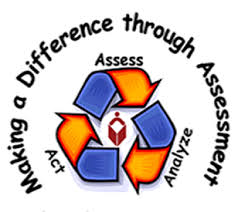
Performance Standard 6: Assessment Uses:
The teacher systematically gathers, analyzes, and uses relevant data to measure student progress, to inform instructional content and delivery methods, and to provide timely and constructive feedback to both students and parents.
|
Performance Indicators at the Level III Level
|
|
6.1 Uses diagnostic assessment data to develop learning goals for students, to differentiate instruction, and to document learning.
6.2 Plans a variety of formal and informal assessments aligned with instructional results to measure student mastery of learning objectives.
6.3 Uses assessment tools for both formative and summative purposes to inform, guide, and adjust instruction.
6.4 Systematically analyzes and uses data to measure student progress, to design appropriate interventions, and to inform long- and short-term instructional decisions.
6.5 Shares accurate results of student progress with students, parents, and key school personnel.
6.6 Provides constructive and frequent feedback to students on their progress toward their learning goals.
6.7 Teaches students how to self-assess and to use metacognitive strategies in support of lifelong learning
|
|
Performance Rubrics
|
|
Level I
|
Level II
|
Level III
|
Level IV
|
|
The teacher candidate does not gather, analyze, or use relevant data to measure student progress, to inform instructional content and delivery methods, or to provide feedback in a constructive or timely manner.
|
The teacher candidate inconsistently gathers, analyzes, or uses relevant data to measure student progress, inconsistently uses data to inform instructional content and delivery methods, or inconsistently provides timely or constructive feedback.
|
The teacher candidate systematically and consistently gathers, analyzes, and uses relevant data to measure student progress, to inform instructional content and delivery methods, and to provide timely and constructive feedback to both students and other relevant stakeholders.
|
The teacher candidate continually demonstrates expertise in using data to measure student progress and effectively uses data to inform instructional decisions. (Teacher candidates rated as Exemplary continually seek ways to serve as role models or teacher leaders. This level is not intended for formative assessments of teacher candidates and may only be used in the summative assessment with proper documentation of the teacher candidate’s consistent performance at this level.)
|
|
Examples of Evidence/Artifacts to demonstrate performance on this standard:
|
- Uses appropriate questions to assess content knowledge.
- Uses data to plan and implement flexible grouping.
- Uses data to identify knowledge and skill gaps and adjust instruction.
- Makes adjustments, as needed, for individuals, small groups, and/or whole groups.
- Remediate the progress of students who did not achieve mastery.
- Provide opportunities for students to reflect on their performance themselves and ask questions.
- Use assessment data to self-assess instructional effectiveness and identify areas of strengths and weaknesses.
- Assess, comment on, and discuss work in class.
- Interpret data of assessments accurately and make inferences about student progress and challenges.
|
|
What it is:
|
What it isn't:
|
- Using the results of student assessment systematically and intelligently.
- Gathering important information about student understanding to make prompt instructional modification - evidence of students’ knowledge and understanding.
- Providing timely and informative feedback to students.
- Enabling students to set and attain meaningful goals.
- Using progress monitoring for information of the strengths and weaknesses in student learning to make better decision on what instructional modifications are necessary.
- Using various techniques (such as questioning, classroom observation) to diagnose student learning and then adjust instruction promptly to close the gap between where the students are now and where the students should be.
- Being aware when students begin to indicate unengaged behaviors that can be the result of poorly planned activities, inadequate scaffolding and modeling, or insufficient attention to developing norms and participation routines in the classroom.
- Giving feedback to students that focuses on developing skills, understanding, and mastery, and treat mistakes as opportunities to learn is particularly effective.
- Providing effective feedback that targets students’ specific misconceptions or errors that occur in a content area or a skill set and that provide informative guidance on what they need to do to maximize their performance.
- Aligning intended learning outcomes, instruction, and assessment to effectively keep track of students’ progress.
- Using high-quality homework and classroom quizzes to review student performance on key knowledge and skills, and providing meaningful and timely feedback.
- Targeting areas of strength and weakness to provide appropriate remediation.
- Identifying students in need of additional or different forms of instruction.
- Enhancing instructional decision-making by assessing the adequacy of student progress to determine when instructional modifications are necessary.
- Having multiple opportunities to achieve mastery and improve grades.
- Articulating assessment procedures.
|
- Results of assessments are shelved and collect dust
- Require simple yes or no answers
- Belief that feedback is to arduous and painstaking to do
|
|
Sample Questions for Conferencing:
|
- How do you use assessment data to plan instruction based on student and sub-group need?
- How do you monitor students and use various types of data to assess student needs?
- What types of data do you use?
- Give an example of a student for whom you identified a need and provided an intervention?
|
Reference and for more information visit
https://www.gadoe.org/School-Improvement/Teacher-and-Leader-Effectiveness/Documents/TKES%20Fact%20%20Sheets%207-11-2012.pdf
